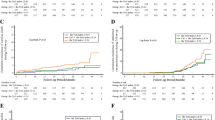Abstract
Background
The most superior GFR-estimating equation from the viewpoint of cardiovascular disease (CVD) prediction remains unclear. Thus, we performed cross-sectional comparison between two GFR-estimating equations (Japanese GFR equation and coefficient-modified CKD-EPI equation) and CVD incidence using Japanese nationwide “specific health checkup” data.
Methods
We recruited Japanese residents (241,159 individuals; mean 63 years; male, 38.6 %) who had not experienced CVD event (cardiac disease or stroke, or both). We calculated estimated GFR using two equations, and compared their predictive value for first symptomatic CVD event within 1 year.
Results
Of all subjects, the mean GFR estimated by the Japanese GFR equation (JPN-eGFR) modified for Japanese was 75.83 ± 16.18 mL/min/1.73 m2, and that by the coefficient-modified CKD-EPI equation (mCKDEPI-eGFR) was 76.39 ± 9.61 mL/min/1.73 m2. Area under the receiver operating characteristics curves (95 % confidence intervals) for predicting CVD event by mCKDEPI-eGFR vs. JPN-eGFR were 0.596 (0.589–0.603) vs. 0.562 (0.554–0.569). Using mCKDEPI-eGFR, the crude odds ratio (OR) for CVD incident in the 4th quartile group was far more than double (OR 2.46, 95 % CI 2.29–2.66) that in the 1st quartile group. Using JPN-eGFR, the crude OR in the 4th quartile group was less than double (OR 1.61, 95 % CI 1.51–1.73) that in the 1st quartile group. However, such superior predictive value of mCKDEPI-eGFR disappeared after adjustment for confounding factors (age, gender, BMI, presence of proteinuria, hypertension, diabetes, dyslipidemia and current smoking).
Conclusion
GFR estimated by the coefficient-modified CKD-EPI equation was more closely related to CVD incidence than that estimated by the Japanese GFR equation. However, it is possible that low mCKDEPI-eGFR also reflects some cardiovascular risk(s) other than kidney dysfunction.


Similar content being viewed by others
References
Go AS, Chertow GM, Fan D, McCulloch CE, Hsu CY. Chronic kidney disease and the risks of death, cardiovascular events, and hospitalization. N Engl J Med. 2004;351:1296–305.
Ninomiya T, Kiyohara Y, Kubo M, Tanizaki Y, Doi Y, Okubo K, et al. Chronic kidney disease and cardiovascular disease in a general Japanese population: the Hisayama study. Kidney Int. 2005;68:228–36.
Nakayama M, Metoki H, Terawaki H, Ohkubo T, Kikuya M, Sato T, et al. Kidney dysfunction as a risk factor for first symptomatic stroke events in a general Japanese population—the Ohasama study. Nephrol Dial Transplant. 2007;22:1910–5.
Landray MJ, Wheeler DC, Lip GY, Newman DJ, Blann AD, McGlynn FJ, et al. Inflammation, endothelial dysfunction, and platelet activation in patients with chronic kidney disease: the Chronic Renal Impairment in Birmingham (CRIB) study. Am J Kidney Dis. 2004;43:244–53.
Terawaki H, Yoshimura K, Hasegawa T, Matsuyama Y, Negawa T, Yamada K, et al. Oxidative stress is enhanced in correlation with renal dysfunction. Kidney Int. 2004;66:1988–93.
Matsuo S, Imai E, Horio M, Yasuda Y, Tomita K, Nitta K, et al. Collaborators developing the Japanese equation for estimated GFR. Revised equations for estimated GFR from serum creatinine in Japan. Am J Kidney Dis. 2009;53:982–92.
Levey AS, Stevens LA, Schmid CH, Zhang YL, Castro AF 3rd, Feldman HI, et al. CKD-EPI (chronic kidney disease epidemiology collaboration). A new equation to estimate glomerular filtration rate. Ann Intern Med. 2009;150:604–12.
Earley A, Miskulin D, Lamb EJ, Levey AS, Uhlig K. Estimating equations for glomerular filtration rate in the era of creatinine standardization: a systemic review. Ann Intern Med. 2012;156:785–95.
Matsushita K, Mahmoodi BK, Woodward M, Emberson JR, Jafar TH, Jee SH, et al. Chronic kidney disease prognosis consortium. Comparison of risk prediction using the CKD-EPI equation and the MDRD study equation for estimated glomerular filtration rate. JAMA. 2012;307:1941–51.
Ohsawa M, Tanno K, Itai K, Turin TC, Okamura T, Ogawa A, et al. Comparison of predictability of future cardiovascular events between chronic kidney disease (CKD) stage based on CKD epidemiology collaboration equation and that based on modification of diet in renal disease equation in the Japanese general population—Iwate KENCO Study. Circ J. 2013;77:1315–25.
Ministry of Health, Labour, and Welfare, Japan Standard program of health checkup and health guidance. Cited in 2007. URL http://www.mhlw.go.jp/bunya/shakaihosho/iryouseido01/info03a.html (in Japanese).
Horio M, Imai E, Yasuda Y, Watanabe T, Matsuo S. Modification of the CKD epidemiology collaboration (CKD-EPI) equation for Japanese: accuracy and use for population estimates. Am J Kidney Dis. 2010;56:32–8.
Kanda Y. Investigation of the freely available easy-to-use software ‘EZR’ for medical statistics. Bone Marrow Transplant. 2013;48:452–8.
Iseki K, Asahi K, Moriyama K, Tsuruya K, Yoshida H, Fujimoto S, et al. Risk factor profiles based on estimated glomerular filtration rate and dipstick proteinuria among participants of the Specific Health Check and Guidance System in Japan 2008. Clin Exp Nephrol. 2012;16:244–9.
Kimoto E, Shoji T, Shinohara K, Hatsuda S, Mori K, Fukumoto S, et al. Regional arterial stiffness in patients with type 2 diabetes and chronic kidney disease. J Am Soc Nephrol. 2006;17:2245–52.
Kumai Y, Kamouchi M, Hata J, Ago T, Kitayama J, Nakane H, et al. FSR investigators. Proteinuria and clinical outcomes after ischemic stroke. Neurology. 2012;78:1909–15.
Otani H, Kikuya M, Hara A, Terata S, Ohkubo T, Kondo T, et al. Association of kidney dysfunction with silent lacunar infarcts and white matter hyperintensity in the general population: the Ohasama study. Cerebrovasc Dis. 2010;30:43–50.
Acknowledgments
This study was supported by Health and Labour Sciences Research Grants for ‘‘Study on the appropriate states of Specific Health Checkups and Specific Health Guidance for prevention of CKD progression” and “Design of the comprehensive health care system for chronic kidney disease (CKD) based on the individual risk assessment by Specific Health Checkups” from the Ministry of Health, Labour and Welfare of Japan.
Conflict of interest
The authors have declared that no conflict of interest exists.
Author information
Authors and Affiliations
Corresponding author
Electronic supplementary material
Below is the link to the electronic supplementary material.
About this article
Cite this article
Terawaki, H., Nakayama, M., Asahi, K. et al. Comparison of predictive value for first cardiovascular event between Japanese GFR equation and coefficient-modified CKD-EPI equation. Clin Exp Nephrol 19, 387–394 (2015). https://doi.org/10.1007/s10157-014-0997-7
Received:
Accepted:
Published:
Issue Date:
DOI: https://doi.org/10.1007/s10157-014-0997-7




